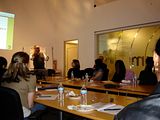


Media Myths & Realities: A Comprehensive Media-Usage Survey
The first official YP meeting of the year took place on February 21st at Ketchum and explored an important question PR professionals have been asking recently: is traditional media dead? Media experts Jerry Swerling, USC Professor of Professional Practice and Director of Public Relations Studies, and Sean Fitzgerald, partner and managing director of Ketchum’s California offices, discussed the realities of consumer media usage today using a study USC Annenberg School for Communication and Ketchum released in December. The study found that traditional media is not dead, debunked other communications myths, discussed how consumers are using media to fit their needs and provided tips for PR practitioners to better reach their target audiences. Here are the ten key learnings of the study:
1. All Media is Local and Personal
Consumers rely heavily on their local newspapers and TV news because they widely believe these sources are credible.
2. The Human Channel is Critical - Especially Word of Mouth
Advice from family and friends is used by nearly half (43.7%) of consumers and they rank this group's credibility high. This is the reason social networking websites are popular.
Practical Tip: Since word-of-mouth influence ranks high among consumers, PR campaigns should consider avenues for developing programs that influence – whether through grass-roots marketing, free product samples and coupons, or other approaches.
3. Consumers Use a Multi Channel Approach
Traditional media continues to be used by a majority of consumers as they are also trying emerging new media.
4. Media Use is Generational
Not surprisingly, younger consumers are more well rounded when it comes to media use. However, older consumers still regularly rely on traditional media.
Practical Tip: Practitioners must be mindful of the media interests of the age groups they are communicating to since their interests vary. Specific “age group specialists” may become an industry trend.
5. Corporate Communicators Rely Too Heavily On Their Company Websites
Consumers report low usage of company's websites for information, ranging from 7 to 22 percent, depending on what type of information they seek.
6. Corporate Communicators Should Use All Media When Spreading Their Message
Consumers are looking more toward a mix of traditional media and in some cases news Web sites to get information. Young adults seek instant news.
7. Timing Matters – Corporate Communicators Must Place Consumers’ Needs Ahead of Company Schedules
Consumers reported that "back to school" time was the number one time they seek out information.
8. Celebrities Should Be Used Strategically and Cautiously
Celebrity endorsement doesn’t rank very high among consumers (13.8%) as a direct influence and has low credibility.
9. Influencers Devour All Media All The Time
Influencers are society’s informational editors and “multi-media-minders."
10. Influencers Adopt New Media Earliest
Compared to other consumer groups, influencers are more influenced by new media and tend to be early adopters to these new communications channels.
Your Responses to the Topic
What key learning do you most agree with? Are you incorporating this insight into your communication plans?




2 comments:
The key learning my team uses most often in our PR agency is the multi-channel approach. We call it surround sound marketing, which means we want consumers to know about our client's product, etc. throughout the day at various "touch points." The new idea I learned at February's meeting was that we should target our above approach depending on the age of our target audience. We try to do this, but now I know its importance in society today.
Post a Comment